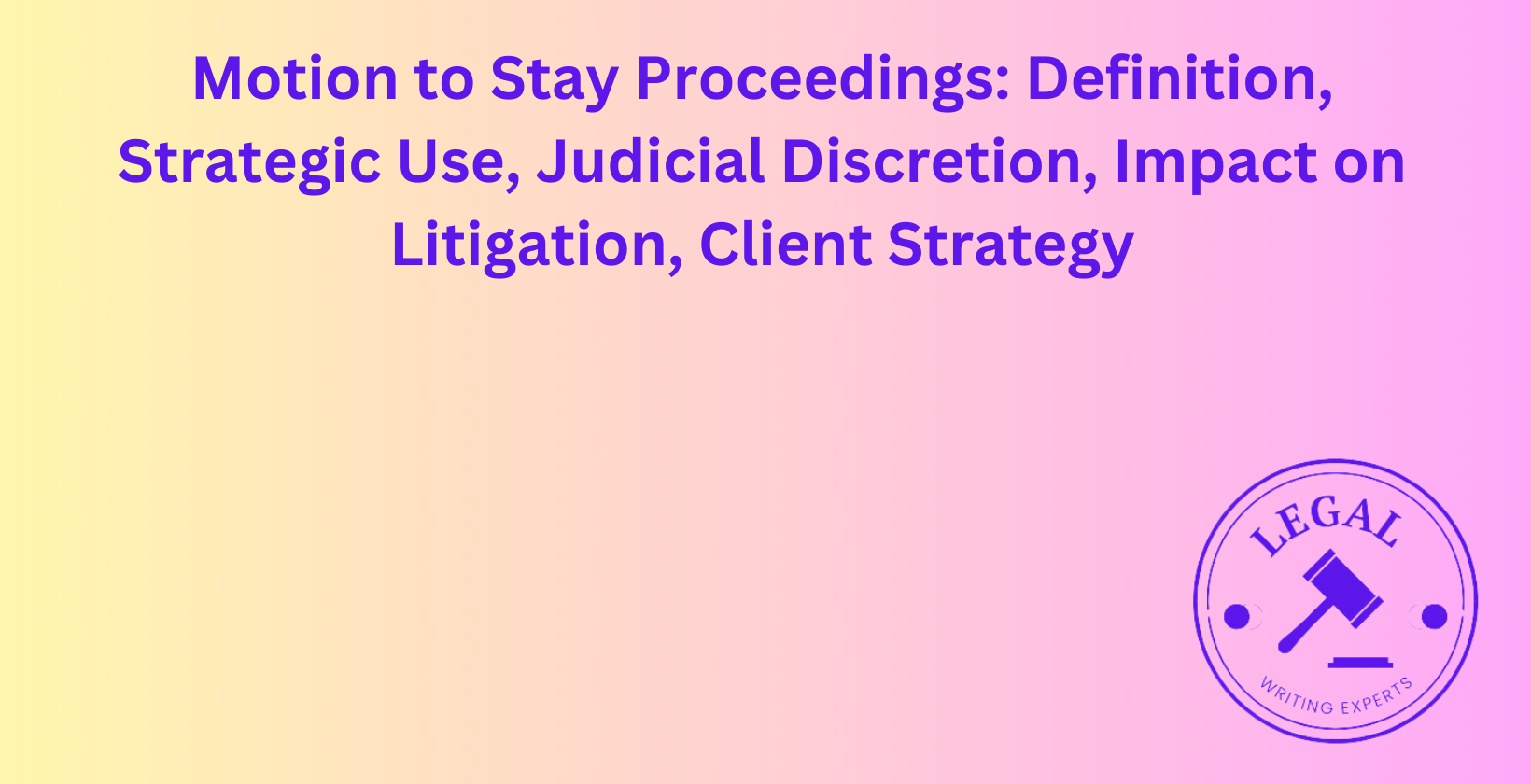Motion to Stay Proceedings
Written by
Jessica E
Septermber 26, 2024 · 8 min read

A motion to stay proceedings is a legal request to halt or suspend court proceedings temporarily. This article explores the definition, strategic uses, and impact of motions to stay, as well as factors influencing judicial discretion in granting stays. We’ll examine how to write and file such motions, their effects on ongoing litigation, and their role in client legal strategy. The article covers different types of stays, common case examples, and the consequences of denied motions. We’ll compare stays to continuances and discuss the duration and grounds for lifting stays.
What Is a Motion to Stay Proceedings?
A motion to stay proceedings is a formal request submitted to the court asking to temporarily halt or suspend all or part of a legal proceeding. This legal mechanism allows parties to pause litigation for various reasons, such as awaiting the outcome of a related case, addressing new legal developments, or pursuing alternative dispute resolution methods.
How to Write a Motion to Stay Proceedings?
To write a motion to stay proceedings, begin by clearly stating the request for a stay and the specific reasons justifying it. Include relevant case details, citing applicable laws or precedents, and explain how the stay serves the interests of justice. Provide a concise statement of facts, outline any potential harm without a stay, and propose a timeline for the stay’s duration. Conclude with a formal request for the court to grant the motion.
Where to Hire a Legal Writer to Draft a Motion to Stay Proceedings?
Legal writers can be hired through the legal writing experts online platform. Legal writing experts offer specialized legal writing services and connect clients with qualified and experienced writers.
How to File a Motion to Stay Proceedings?
First, prepare the motion document according to local court rules to file a motion to stay proceedings. Then, file the motion with the clerk of the court where the case is pending, paying any required filing fees. Following proper service procedures, serve copies of the motion to all parties involved in the case and file proof of service with the court to confirm that all parties received the motion. Schedule a hearing date if required by local rules or the judge’s preferences.
What Are the Strategic Uses of a Motion to Stay Proceedings?
Strategic uses of a motion to stay proceedings include preserving resources by pausing costly litigation while pursuing settlement negotiations. It can be used to await the outcome of a related case that may impact the current proceedings. Stays allow time to gather additional evidence or address new legal developments. They can be employed to manage complex multi-jurisdictional litigation or to coordinate parallel proceedings. Motions to stay may be used to protect a client’s interests during bankruptcy proceedings or to allow for the resolution of preliminary legal issues before proceeding with the main case.
What Factors Influence Judicial Discretion in Granting a Stay?
Factors influencing judicial discretion in granting a stay include the likelihood of success on the case’s merits, potential irreparable harm to the moving party if the stay is denied, potential harm to other parties if the stay is granted, and the public interest. Courts consider the proceedings‘ stage, the expected duration of the stay, and whether the stay would promote judicial economy. The complexity of the case, the conduct of the parties, and the impact on court resources are additional factors. Judges may weigh the balance of equities and assess whether the stay would unfairly prejudice any party.
How Does a Motion to Stay Impact Ongoing Litigation?
A motion to stay impacts ongoing litigation by temporarily halting all or part of the legal proceedings. It suspends deadlines, discovery processes, and scheduled hearings or trials. The stay may affect the case’s momentum, potentially altering negotiation dynamics between parties. It can provide time to reassess legal strategies or explore settlement options. The stay may impact the preservation of evidence and witness availability. It can affect the court’s docket management and potentially influence the overall duration of the litigation process.
What Are the Legal Standards for Granting a Stay of Proceedings?
The legal standards for granting a stay of proceedings involve a multi-factor test. Courts often consider:
(1) the likelihood of success on the merits of the appeal or underlying case
(2) the potential for irreparable harm to the moving party if the stay is denied
(3) the balance of hardships between the parties
(4) the public interest.
Some jurisdictions may require a showing of “good cause” or “exceptional circumstances” to justify a stay. The moving party generally bears the burden of demonstrating that the balance of factors favors granting the stay.
What Are the Types of Stays That the Court Can order?
The types of stays that the court can order include automatic, discretionary, and mandatory stays. Automatic stays occur by operation of law, such as in bankruptcy proceedings. Discretionary stays are granted based on the court’s judgment of the circumstances. Mandatory stays are required by statute or rule in certain situations. Stays can be partial, affecting only specific aspects of the case, or complete, halting all proceedings. Temporary stays may be issued for a defined period, while indefinite stays remain in effect until lifted by the court. Emergency stays can be granted on an expedited basis in urgent situations.
What are Some Common Case Examples that Involve Stays of Proceedings?
Common case examples involving stays of proceedings include bankruptcy cases where an automatic stay prevents creditors from pursuing collection actions. In multi-district litigation, stays may coordinate proceedings across different jurisdictions. Appeals of denials of motions to compel arbitration often result in stays of the underlying litigation. Cases involving parallel criminal and civil proceedings may see stays to protect a defendant’s Fifth Amendment rights. International disputes may involve stays pending resolution of jurisdictional issues. Class action certifications or appeals may lead to stays of individual claims. Cases affected by new legislation or pending Supreme Court decisions often see stays to await legal clarity.
What Is the Difference Between a Motion to Stay and a Motion for Continuance?
The difference between a motion to stay and a motion for continuance lies in their scope and purpose. A motion to stay seeks to suspend all or part of the legal proceedings for a period of time, potentially affecting multiple aspects of the case. A motion for continuance, on the other hand, typically requests a delay or postponement of a specific event or deadline within the case, such as a hearing or trial date. Stays are broader in effect and often relate to external factors or parallel proceedings, while continuances are more limited and usually address scheduling conflicts or the need for additional preparation time.
How Can a Motion to Stay Be Used as Part of a Client’s Legal Strategy?
A motion to stay can be part of a client’s legal strategy to gain tactical advantages. It can provide time to strengthen a case by gathering additional evidence or addressing weaknesses. Stays can be used to manage resources more effectively, especially in complex litigation. They can create opportunities for settlement negotiations without the pressure of ongoing litigation. In multi-forum disputes, stays can help coordinate proceedings for optimal outcomes. Clients may use stays to await favorable changes in law or precedent. Strategically timed stays can influence the pace of litigation to align with a client’s broader business or personal objectives.
What Are the Consequences of a Denied Motion to Stay Proceedings?
The consequences of a denied motion to stay proceedings include continuing the litigation as scheduled. Parties must proceed with discovery, motion practice, and trial preparation according to existing deadlines. The denial may result in increased litigation costs and resource expenditure. It can impact settlement leverage and negotiation dynamics. Sometimes, a denied stay may lead to parallel proceedings in different forums, potentially resulting in conflicting outcomes. The moving party may face challenges in managing multiple legal fronts simultaneously. There may be strategic implications for case management and the overall litigation approach.
How Long Can a Stay of Proceedings Last?
The duration of a stay of proceedings varies depending on the circumstances and the court’s order. Stays can be short-term, lasting days or weeks, or long-term, extending for months or even years. In some cases, stays may be indefinite, remaining in effect until a specific condition is met or the court lifts the stay. The length often depends on the reason for the stay, such as the duration of a related appeal or the resolution of a parallel proceeding. Courts may set specific time limits or require periodic status updates to reassess the need to continue the stay.
What Are the Grounds for Lifting a Stay of Proceedings?
Grounds for lifting a stay of proceedings include the resolution of the issue that prompted the stay, such as the conclusion of a related case or appeal. Changed circumstances that eliminate the need for the stay can be grounds for lifting it. If the stay was granted for a specific time period, its expiration naturally leads to lifting. Courts may lift stays if they determine that continuing the stay would cause undue prejudice to a party or no longer serve the interests of justice. Failure to comply with the conditions of the stay or engage in good faith efforts to resolve the underlying issues can lead to its termination. Parties can motion the court to lift a stay if they believe the reasons for granting it no longer apply.
Meet the Author
Distinguished linguist at Legal Writing Experts
Jessica is an expert legal writer with a remarkable blend of legal knowledge and linguistic precision. She earned her Juris Doctor degree from Duke University, where she attended on a prestigious Law Faculty Merit Scholarship. At Duke, Jessica demonstrated her exceptional abilities by serving as an editor of the Duke Law Review.
After graduating, Jessica further refined her skills during a two-year appellate clerkship at a distinguished law firm in North Carolina. Throughout law school, she enhanced her research and writing expertise as a research assistant and writer for various legal firms. Jessica’s deep understanding of legal language and meticulous attention to detail make her an invaluable asset to our legal writing services.


